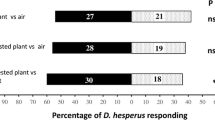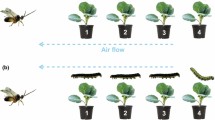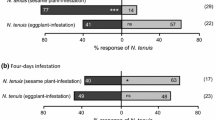Abstract
Using Cotesia vestalis, a parasitoid wasp of diamondback moth larvae and three crucifer plant species (cabbage, komatsuna, and Japanese radish), we examined the effects of exposure to host-infested plant volatiles from one plant species on a newly emerged wasp’s subsequent olfactory cognition of host-infested plant volatiles from the same or different plant species. The preference of C. vestalis between infested and uninfested plant volatiles was tested in a choice chamber. Volatile-inexperienced wasps significantly preferred infested cabbage and infested radish volatiles, but not infested komatsuna volatiles. After exposure to infested cabbage volatiles, wasps showed a significant preference for infested cabbage volatiles, while the significant preference for infested radish volatiles that had been observed in inexperienced wasps was no longer observed. After exposure to infested komatsuna volatiles, wasps significantly preferred infested komatsuna volatiles, and the pre-exposure significant preferences for infested cabbage volatiles and infested radish volatiles remained. After exposure to infested radish volatiles, the significant preferences for infested cabbage and infested radish volatiles did not change. Furthermore, wasps showed a significant preference for infested komatsuna volatiles. The compound compositions of the volatile blends from the three infested plant species were grouped separately in a principal coordinates analysis. The experience-based cognition of C. vestalis for host-infested plant volatiles of three plant species is discussed.



Similar content being viewed by others
References
Arimura G, Matsui K, Takabayashi J (2009) Chemical and molecular ecology of herbivore-induced plant volatiles: proximate factors and their ultimate functions. Plant Cell Physiol 50:911–923. doi:10.1093/pcp/pcp030
Bates D, Maechler M, Bolker B (2014) lme4: linear mixed-effects models using Eigen and S4. R package version 1.1–7. http://CRAN.R-project.org/package=lme4
Blande JD, Pickett JA, Poppy GM (2007) A comparison of semiochemically mediated interactions involving specialist and generalist Brassica-feeding aphids and the braconid parasitoid Diaeretiella rapae. J Chem Ecol 33:767–779. doi:10.1007/s10886-007-9264-7
de Moraes CM, Lewis WJ, Pare PW, Alborn HT, Tumlinson JH (1998) Herbivore-infested plants selectively attract parasitoids. Nature 393:570–573
Dicke M, Sabelis MW, Takabayashi J, Bruin J, Posthumus MA (1990) Plant strategies of manipulating predator-prey interactions through allelochemicals: prospects for application in pest control. J Chem Ecol 16:3091–3118. doi:10.1007/BF00979614
Fujiwara C, Takabayashi J, Yano S (2000a) Effects of host-food plant species on parasitization rates of Mythimna separata (Lepidoptera: Noctuidae) by a parasitoid, Cotesia kariyai (Hymenoptera: Braconidae). Appl Entomol Zool 35:131–136. doi:10.1303/aez.2000.131
Fujiwara C, Takabayashi J, Yano S (2000b) Oviposition experience on a host-infested plant affects flight and antennal searching behavior of Cotesia kariyai toward the host-plant complex. Entomol Exp Appl 97:251–256. doi:10.1046/j.1570-7458.2000.00737.x
Fukushima J, Kainoh Y, Honda H, Takabayashi J (2001) Learning of host-infested plant volatiles in the larval parasitoid Cotesia kariyai. Entomol Exp Appl 99:341–346. doi:10.1046/j.1570-7458.2001.00833.x
Fukushima J, Kainoh Y, Honda H, Takabayashi J (2002) Learning herbivore-induced and unspecific plant volatiles by a parasitoid Cotesia kariyai. J Chem Ecol 28:563–567. doi:10.1023/A:1014548213671
Geervliet JBF, Vet LEM, Dicke M (1996) Innate responses of the parasitoids Cotesia glomerata and C. rubecula (Hymenoptera: Braconidae) to volatiles from different plant-herbivore complexes. J Insect Behav 9:525–538. doi:10.1007/BF02213877
Ghirlanda S, Enquist M (2003) A century of generalization. Anim Behav 66:15–36. doi:10.1006/anbe.2003.2174
Girling RD, Hassall M, Turner JG, Poppy GM (2006) Behavioural responses of the aphid parasitoid Diaeretiella rapae to volatiles from Arabidopsis thaliana induced by Myzus persicae. Entomol Exp Appl 120:1–9. doi:10.1111/j.1570-7458.2006.00423.x
Goldstone RG (1998) Perceptual learning. Annu Rev Phychol 49:585–612
Kester KM, Barbosa P (1991) Postemergence learning in the insect parasitoid, Cotesia congregata. J Insect Behav 4:727–742
Kester KM, Barbosa P (1992) Effects of postemergence experience of searching and landing responses of the insect parasitoid, Cotesia congregata (Say) (Hymenoptera: Braconidae), to plants. J Insect Behav 5:310–320
Ngumbi E, Jordan M, Fadamiro H (2012) Comparison of associative learning of host-related plant volatiles in two parasitoids with different degrees of host specificity, Cotesia marginivantris and Microplitis croceipes. Chemoecology 22:207–215. doi:10.1007/s00049-012-0106-x
Oksanen J, Blanchet FG, Kindt R, Legendre P, Minchin PR, O’Hara RB,. Simpson GL, Solymos P, Stevens MHH, Wagner H (2016) Vegan: community ecology package. R package version 2.3–5. URL 381 https://CRAN.R-project.org/package=vegan
Peñaflor MFGV, Erb M, Miranda LA, Werneburg AG, Bento JMS (2011) Herbivore-induced plant volatiles can serve as host location cues for a generalist and a specialist egg parasitoid. J Chem Ecol 37:1304–1313. doi:10.1007/s10886-011-0047-9
R Core Team (2016) R: a language and environment for statistical computing. R foundation for statistical. Computing, Vienna, Austria. https://www.R-project.org/
Rim H, Uefune M, Takabayashi J (2015) Olfactory response of the omnivorous mirid bug Nesidiocoris tenuis to eggplants infested by prey: specificity in prey developmental stages and prey species. Biol Control 91:47–54. doi:10.1016/j.biocontrol.2015.07.009
Sabelis M, Takabayashi J, Janssen A, Kant M, van Wijk M, Sznajder B, Aratchige NS, Lesna I, Belliure B, Schuurink RC (2007) Ecology meets plant physiology: herbivore-induced plant responses and their indirect effects on arthropod communities. In: Ohgushi T, Craig T, Price P (eds) Ecological communities: plant mediation in indirect interaction webs. Cambridge University Press, Cambridge, pp 188–217
Shiojiri K, Takabayashi J, Yano S, Takafuji A (2000) Flight response of parasitoid toward plant-herbivore complexes: a comparative study of two parasitoid-herbivore systems on cabbage plants. Appl Entomol Zool 35:87–92
Shiojiri K, Takabayashi J, Yano S, Takafuji A (2001) Infochemically mediated tritrophic interaction webs on cabbage plants. Popul Ecol 43:23–29. doi:10.1371/journal.pone.0012161
Shiojiri K, Ozawa R, Kugimiya S, Uefune M, van Wijk M, Sabelis MW, Takabayashi J (2010) Herbivore-specific, density-dependent induction of plant volatiles: honest or “cry wolf” signals? PLoS One 5:e12161. doi:10.1371/journal.pone.0012161
Storeck A, Poppy GM, van Emden HF, Powell W (2000) The role of plant chemical cues in determining host preference in the generalist aphid parasitoid Aphidius colemani. Entomol Exp Appl 97:41–46. doi:10.1046/j.1570-7458.2000.00714.x
Takabayashi J, Dicke M (1996) Plant-carnivore mutualism through herbivore-induced carnivore attractants. Trends Plant Sci 1:109–113. doi:10.1016/S1360-1385(96)90004-7
Takabayashi J, Dicke M, Posthumus MA (1991) Variation in composition of predator-attracting allelochemicals emitted by herbivore-infested plants: relative influence of plant and herbivore. Chemoecology 2:271–277
Takabayashi J, Dicke M, Posthumus MA (1994) Volatile herbivore-induced terpenoids in plant-mite interactions: variation caused by biotic and abiotic factors. J Chem Ecol 20:1324–1354. doi:10.1007/BF02059811
Takabayashi J, Takahashi S, Dicke M, Posthumus MA (1995) Developmental stage of the herbivore Pseudaletia separata affects production of herbivore-induced synomone by corn plants. J Chem Ecol 21:273–287
Takabayashi J, Sabelis MA, Janssen A, Shiojiri K, van Wijk M (2006) Can plants betray the presence of multiple herbivore species to predators and parasitoids? The role of learning in phytochemical information networks. Ecol Res 21:3–8. doi:10.1007/s11284-005-0129-7
Takemoto H, Powell W, Pickett JA, Kainoh Y, Takabayashi J (2009) Learning is involved in the response of parasitic wasps Aphidius ervi (Haliday) (Hymenoptera: Braconidae) to volatiles from a broad bean plant, Vicia faba (Fabaceae), infested by aphids Acyrthosiphon pisum (Harris) (Homoptera: Aphididae). Appl Entomol Zool 44:23–28. doi:10.1303/aez.2009.23
Takemoto H, Powell W, Pickett JA, Kainoh Y, Takabayashi J (2012) Two-step learning involved in acquiring olfactory preferences for plant volatiles by parasitic wasps. Anim Behav 83:1491–1496. doi:10.1016/j.anbehav.2012.03.023
Tamo C, Ricard I, Held M, Davison AC, Turlings TCJ (2006) A comparison of naive and conditioned responses of three generalist endoparasitoids of lepidopteran larvae to host-induced plant odors. Anim Biol 56:205–220
Turlings TCJ, Wäckers F, Vet LEM, Lewis WJ, Tumlinson JH (1993) Learning of host-finding cues by hymenopterous parasitoids. In: Papaj DR, Lewis AC (eds) Insect learning: ecology and evolutionary perspectives. Chapman and Hall, New York, pp 51–78
Uefune M, Choh Y, Abe J, Shiojiri K, Sano K, Takabayashi J (2012) Application of synthetic herbivore-induced plant volatiles causes increased parasitism of herbivores in the field. J Appl Entomol 136:561–567. doi:10.1111/j.1439-0418.2011.01687.x
Uefune M, Kugimiya S, Ozawa R, Takabayashi J (2013) Parasitic wasp females are attracted to blends of host-induced plant volatiles: do qualitative and quantitative differences in the blend matter? F1000Research 2:57 doi: 10.3410/f1000research.2-57.v1
van Wijk M, de Bruijn PJA, Sabelis MW (2011) Complex odor from plants under attack: herbivore’s enemies react to the whole, not its parts. PLoS One 6:e21742. doi:10.1371/journal.pone.0021742
Yoneya K, Takabayashi J (2012) An apparent trade-off between direct and signal-based induced indirect defence against herbivores in willow trees. PloS One e5150. doi: 10.1371/journal.pone.0051505
Yoneya K, Kugimiya S, Takabayashi J (2009) Can herbivore-induced volatiles inform predatory insects about the most suitable stage of its prey? Physiol Entomol 34:379–386. doi:10.1111/j.1365-3032.2009.00701.x
Acknowledgements
We thank Edanz Group (www.edanzediting.com/ac) for editing a draft of this manuscript. This research was partly supported by the Bio-oriented Technology Research Advancement Institution, by JST “Science and Engineering Entrepreneurship Development Program for Vigorous Researchers (SEED-V),” by Grants-in-Aid for Scientific Research from MEXT (Grant Number 26292030), and by JSPS KAKENHI Grant Number JP26660281.
Funding
This research was partly supported by the Bio-oriented Technology Research Advancement Institution, by the Japanese Society for the Promotion of Science (Grant Number 26660281) to JT, and by the Japan Science and Technology Agency “Science and Engineering Entrepreneurship Development Program for Vigorous Researchers” to MU.
Author information
Authors and Affiliations
Corresponding author
Ethics declarations
Conflict of interest
The authors declare that there is no conflict of interest.
Ethical approval
All applicable international, national, and/or institutional guidelines for the care and use of animals were followed.
Electronic supplementary material
Below is the link to the electronic supplementary material.
Rights and permissions
About this article
Cite this article
Yoneya, K., Uefune, M. & Takabayashi, J. Parasitoid wasps’ exposure to host-infested plant volatiles affects their olfactory cognition of host-infested plants. Anim Cogn 21, 79–86 (2018). https://doi.org/10.1007/s10071-017-1141-3
Received:
Revised:
Accepted:
Published:
Issue Date:
DOI: https://doi.org/10.1007/s10071-017-1141-3




